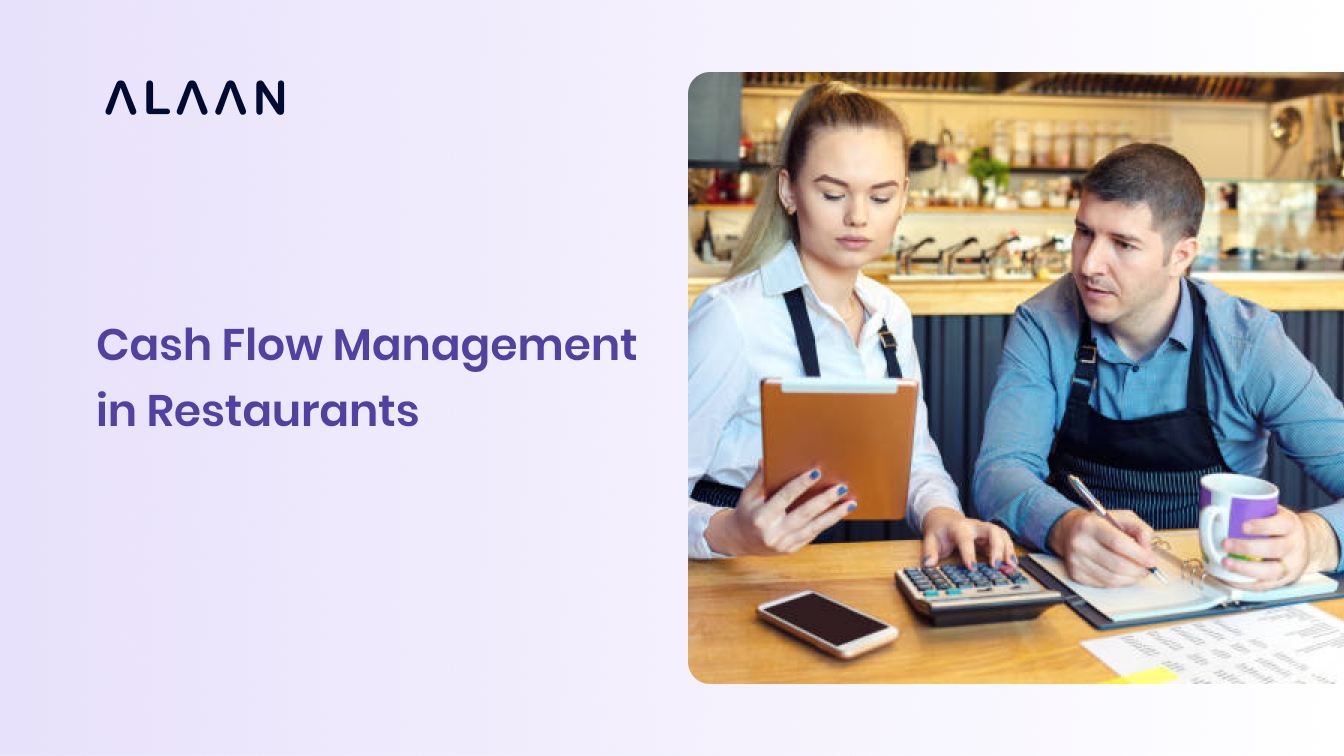Dubai is "on the right path" to becoming the world's food capital. Yet beneath that growth story lies a more complex financial reality. With over 13,000 restaurants now operating across the city, the market is nearing saturation. Every new outlet competes for the same diner, and the same dirham.
In this crowded landscape, even profitable restaurants face liquidity challenges. Rising rent, delivery commissions, and labour costs have pushed average profit margins down to 3–5% across the UAE's F&B sector. When margins are that tight, a short delay in aggregator settlements or supplier payments can quickly strain operations.
These pressures have made cash flow management the most critical financial discipline for restaurant operators today.
This guide outlines practical ways to maintain that flow and keep every dirham working where it should.
Key Takeaways
- Cash Flow Planning: Rolling forecasts and daily liquidity reviews help restaurants anticipate shortfalls and plan payments with precision.
- Expense Automation: Real-time expense tracking and card-level controls eliminate manual errors and strengthen compliance across outlets.
- Cost Efficiency: Optimising labour, supplier terms, and inventory turnover protects already narrow profit margins in a saturated UAE F&B market.
- Financial Visibility: Integrated technology gives finance teams a single source of truth, enabling faster, data-driven decisions on spend and working capital.
Breaking Down Restaurant Cash Flow
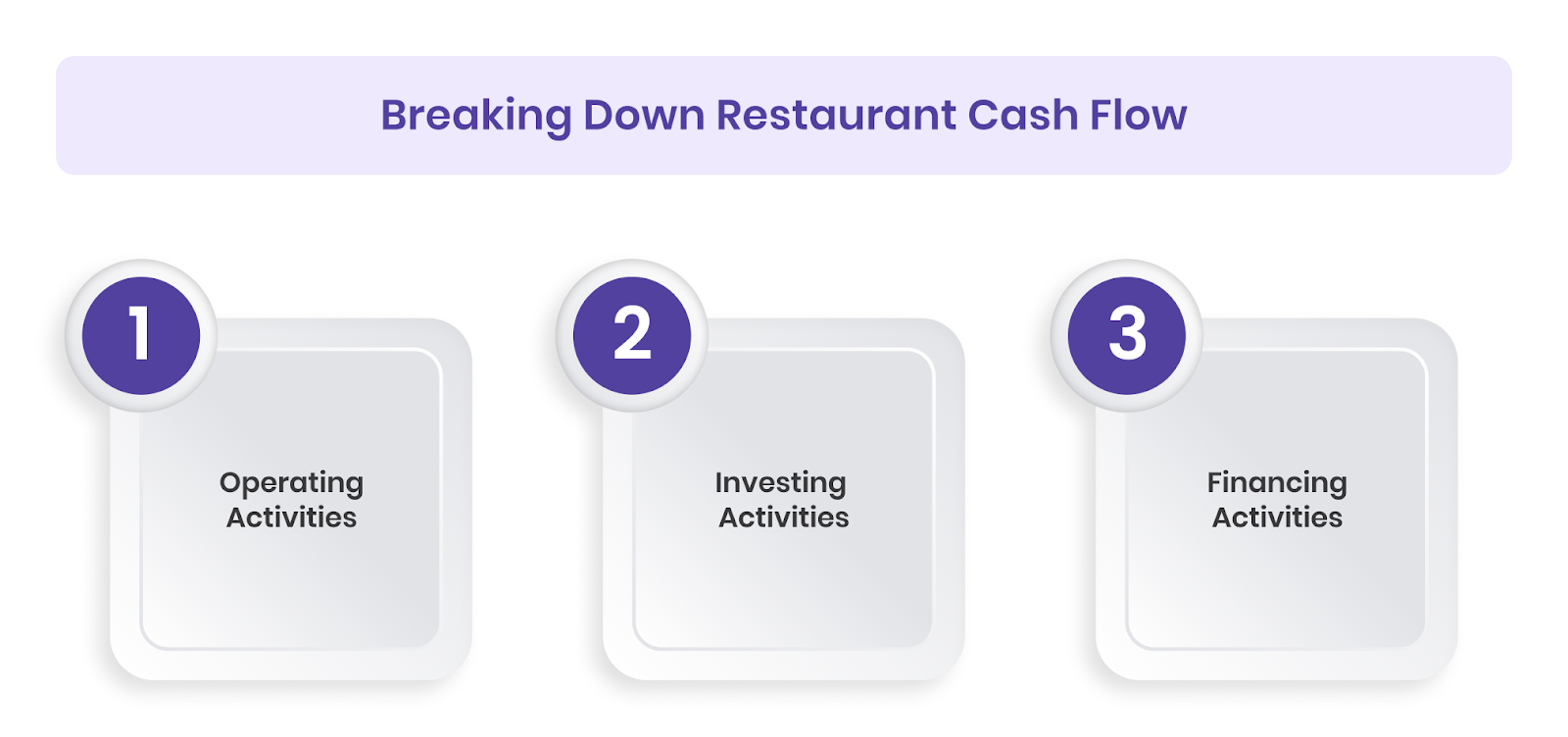
Restaurant cash flow is shaped by three main financial activities that move through the business each month. Understanding these sources helps finance teams plan liquidity and maintain control.
- Operating Activities: This covers routine inflows and outflows such as food sales, supplier payments, payroll, utilities, and rent. For most UAE restaurants, operating cash determines how smoothly daily operations run.
- Investing Activities: Funds used for kitchen upgrades, new equipment, or outlet expansion belong here. These outlays often reduce short-term liquidity but build long-term capacity.
- Financing Activities: This includes capital injections, loan proceeds, and lease obligations. Tracking repayments and interest schedules helps finance managers maintain stable working capital throughout the year.
Formula
Cash Flow = Cash from Operating Activities +/- Cash from Investing Activities +/- Cash from Financing Activities
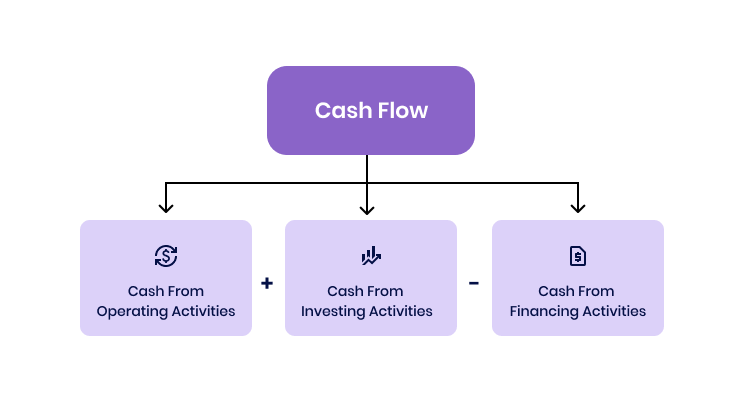
When these three streams are reviewed together, finance teams gain a complete view of how cash moves through the business. This visibility supports better forecasting and strengthens cash flow discipline across outlets.
Also Read: Cost Management in UAE: Key Steps, Benefits & Proven Strategies for 2025
Why Restaurant Cash Flow Is Unusually Challenging in the UAE
Restaurants in the UAE operate in a high-cost market where cash flow depends on timing, not just revenue. Several recurring factors make liquidity difficult to manage.
- Settlement Delays: Delivery platforms and card processors in the UAE often take two to seven days to release payments. When most sales come through these channels, cash stays locked while expenses continue daily.
- Supplier Prepayments: Vendors typically demand upfront payment or short credit terms. Frequent orders for fresh or imported produce keep working capital tied up before sales are realised.
- High Fixed Costs: Prime locations across Dubai and Abu Dhabi command high rent and staffing expenses. These fixed outflows remain constant even when sales slow during off-peak periods.
- VAT Documentation: Strict VAT rules require compliant invoices and accurate records. Missing or delayed receipts reduce recoverable VAT and tighten short-term liquidity.
- Manual Expense Tracking: Many outlets still record expenses manually or consolidate data at month-end. Without daily visibility, small discrepancies compound into larger cash flow gaps.
- Import and Currency Exposure: Fluctuating global prices for key ingredients directly affect UAE menus and purchasing budgets. Price shifts quickly alter weekly outflows, making forecasting harder.
These factors combine to create unpredictable cash cycles. Consistent forecasting, structured payment control, and real-time expense visibility are essential to maintain stability. That’s where Alaan can make a difference, by giving you insight into every transaction, helping automate reconciliation, and surfacing anomalies before they hurt.
Core Techniques for Improving Cash Flow in UAE Restaurants
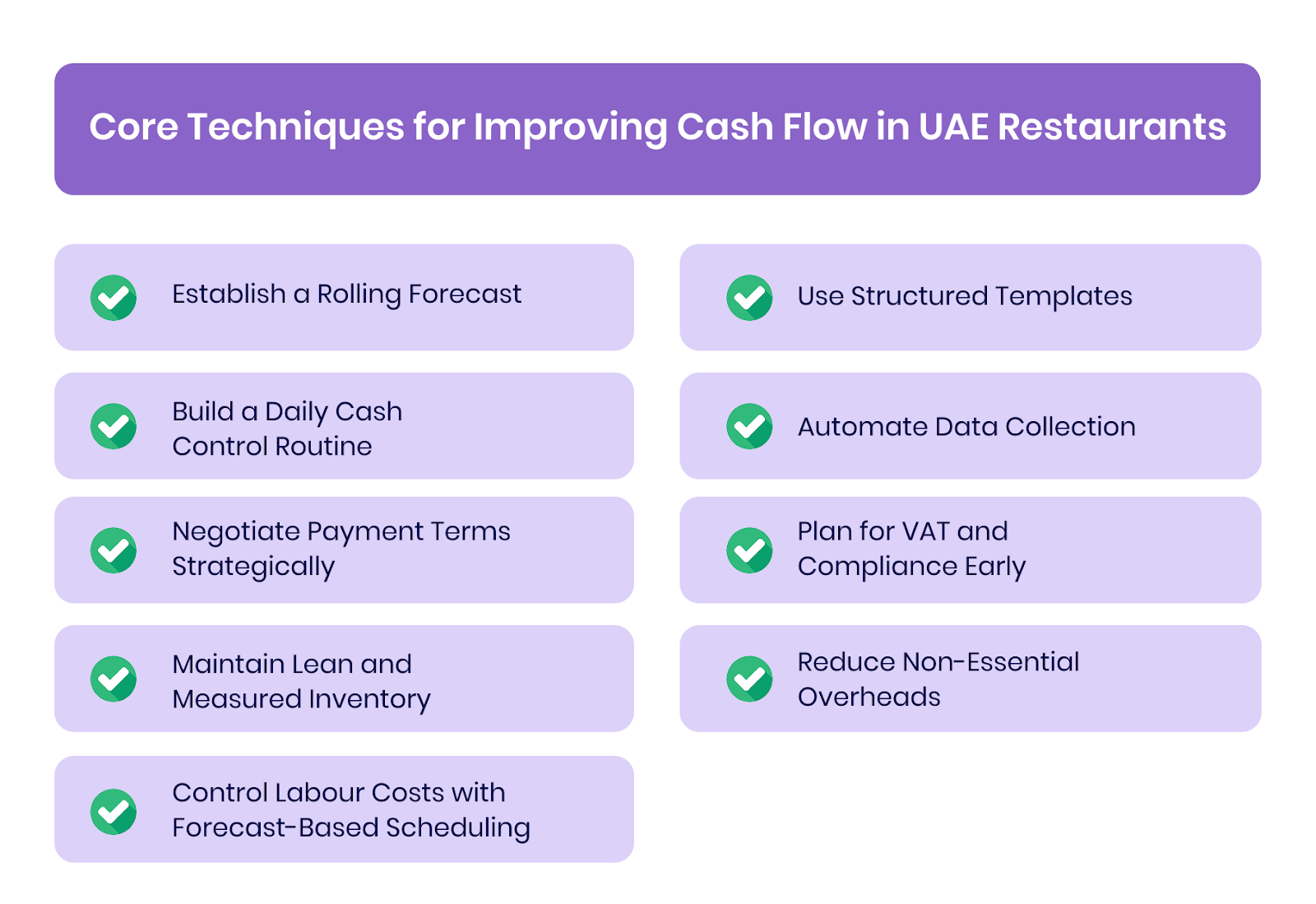
Cash flow strength in restaurants depends on accuracy and routine. Every dirham that enters or leaves the business should be tracked, timed, and verified. These techniques help finance teams maintain stability across daily operations.
1. Establish a Rolling Forecast
Adopt a continuous seven-day and thirty-day forecasting cycle. Update it daily with confirmed inflows from card processors, delivery aggregators, and catering contracts. Record all scheduled outflows such as rent, payroll, and supplier payments.
For example, once you create this daily rhythm, a delayed payout from a delivery partner becomes visible early enough for finance teams to adjust payment dates and preserve liquidity.
2. Build a Daily Cash Control Routine
Review expected collections and upcoming payments each morning before approving new purchases. Apply this across all branches so outlet managers operate from verified balances. Centralised dashboards that display card and bank data make this step faster and more transparent.
3. Negotiate Payment Terms Strategically
Review supplier credit terms and align them with your incoming cash schedule. A modest extension on key inputs, such as meat or dairy, can release short-term liquidity and reduce the need for overdraft facilities.
4. Maintain Lean and Measured Inventory
Track product movement daily and reorder based on actual turnover. Avoid large stockpiles of perishable or imported items that trap working capital.
For example, ordering smaller seafood batches twice a week allows restaurants to reduce waste and keep cash available for essential outflows.
5. Control Labour Costs with Forecast-Based Scheduling
Plan weekly staff schedules according to forecasted sales. Use historical data from POS and delivery reports to match manpower with demand. This helps keep wage costs within target ratios while maintaining service levels.
6. Use Structured Templates
Maintain a consistent cash-flow sheet for each outlet with five columns: Date, Inflows, Outflows, Net Cash, and Cumulative Balance.
Update the sheet daily to keep decision-makers informed of actual liquidity.
7. Automate Data Collection
Connect expense, POS, and banking systems so that every transaction is recorded automatically. Automation removes manual reconciliation, ensures VAT-ready documentation, and provides finance teams with instant visibility.
8. Plan for VAT and Compliance Early
Move VAT-related funds to a separate account as soon as sales are recorded. This prevents shortfalls during filing cycles and simplifies compliance checks for multi-branch operations.
9. Reduce Non-Essential Overheads
Evaluate fixed contracts, maintenance services, and utilities each quarter. Replace long-term agreements with flexible, usage-based plans or energy-efficient systems to reduce recurring expenses.
Strong forecasting routines, automated expense recording, and structured reviews bring predictability to restaurant finances.
At Alaan, we help UAE restaurants manage expenses, track settlements, and maintain real-time visibility across every outlet,so finance leaders can focus on growth with complete control over liquidity.
Also Read: Why and How to Separate Personal and Business Finances
[cta-4]
Tools and Technology That Enable Discipline
Cash flow stability in UAE restaurants depends on how fast finance teams can see, verify, and act on data.
For restaurant operators managing multiple outlets, these technologies convert daily complexity into measurable control.
1. Integrated POS and Accounting Systems
When POS data flows directly into accounting software, revenue becomes visible the moment a sale is made. This helps finance teams predict daily liquidity and schedule supplier payments based on confirmed income rather than delayed reports.
Restaurants using integrated systems also close their books faster and identify settlement delays before they affect vendor payouts.
2. Expense Management Platforms
Expense management platforms like Alaan digitise every payment from the moment it occurs. Each transaction is captured with its receipt, category, and VAT details, creating a live expense register instead of a monthly backlog.
This single view lets restaurant CFOs and owners spot irregular spending instantly, freeing up cash that would otherwise be lost to duplicate or delayed expense claims.
3. Corporate Card Systems with Smart Controls
Corporate cards equipped with spend limits and vendor restrictions act as the first line of defence against uncontrolled outflows.
Finance teams can issue role-based cards for outlet managers, cap transaction values, and block specific merchants, all in real time. These controls eliminate unapproved purchases and maintain tighter liquidity through predictable daily spending.
4. AI-Powered Receipt and Invoice Matching
AI-enabled verification ensures that every expense has a valid, VAT-compliant receipt before it enters the books.
By scanning and matching invoices automatically, finance teams reduce manual work and prevent missing VAT input claims, a common cause of cash strain during filing periods.
5. Accounting Automation and ERP Integrations
Automated journal entries and categorisation keep records current. Instead of waiting until month-end, every expense and settlement is posted in real time, giving finance managers an accurate view of their working capital. This continuity improves forecasting accuracy and supports smoother VAT compliance.
6. Centralised Dashboards for Multi-Outlet Visibility
Restaurants with multiple branches often struggle to consolidate data quickly. A centralised dashboard showing daily inflows, outflows, and pending payables gives management complete visibility.
Finance heads can compare branch performance, detect anomalies, and shift funds across outlets when needed to maintain liquidity.
7. VAT and Compliance Automation
VAT automation ensures accuracy at source. Each receipt is validated for supplier TRN, amount, and invoice details before submission.
This prevents rejected claims and keeps recoverable VAT flowing back into the business, protecting working capital in a system where tax deadlines are fixed and penalties are high.
Technology gives finance teams the visibility and timing that manual systems can’t. At Alaan, we help UAE restaurants combine these capabilities in one platform, automating expenses, controlling spend, and maintaining real-time visibility across outlets, so finance leaders can forecast confidently and keep cash flow steady every single day.
Key KPIs for Restaurant Cash Flow Tracking in the UAE
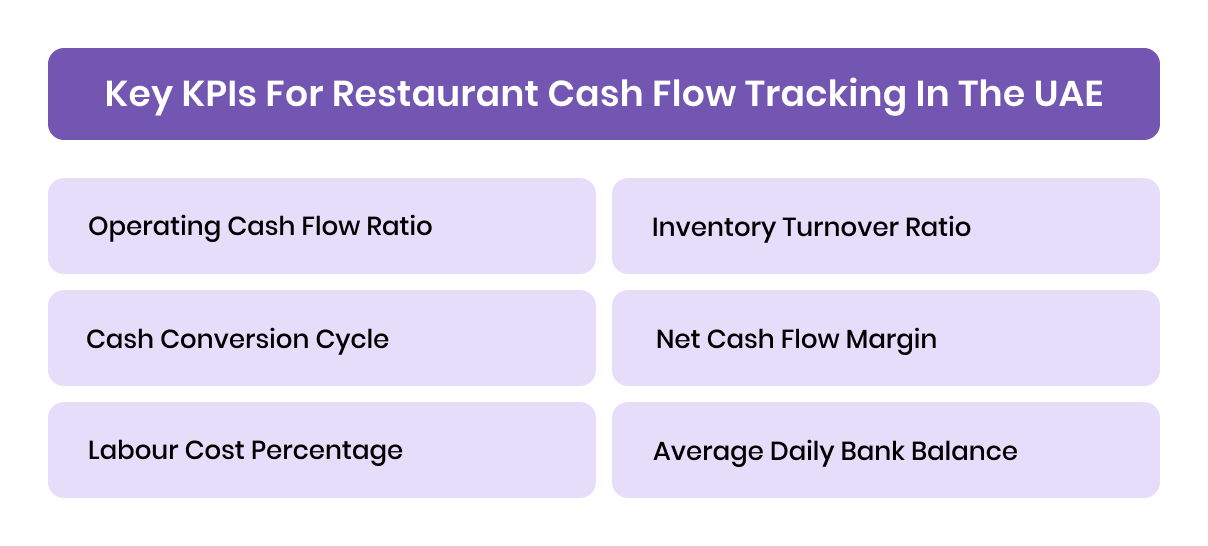
Even with automation and strong routines, cash flow discipline depends on continuous measurement. For UAE restaurants, the right metrics reveal where cash stalls, where it leaks, and how quickly it returns. These KPIs help finance teams convert data into control.
1. Operating Cash Flow Ratio
This ratio shows whether daily operations generate enough cash to cover current obligations.
Formula: Operating Cash Flow ÷ Current Liabilities
A value above 1.0 indicates the restaurant's operations can fund themselves without borrowing.
For example, if a Dubai casual dining outlet generates AED 300,000 in monthly operating cash and has AED 240,000 in current liabilities, its ratio is 1.25 — signalling strong liquidity.
2. Cash Conversion Cycle (CCC)
CCC measures how long cash takes to complete one full business cycle—from purchasing supplies to collecting customer payments.
Formula: Days Inventory + Days Receivable − Days Payable
Lower is better. UAE restaurants typically target a cycle of under 20 days. Longer cycles often mean overstocking or delayed settlements from aggregators.
3. Labour Cost Percentage
This metric tracks payroll cost efficiency.
Formula: (Total Labour Cost ÷ Total Sales) × 100
For quick-service restaurants, the healthy range is 20–25%. For fine dining, it can extend to 30–35%.
Regular tracking ensures schedules remain aligned with forecasted demand, protecting cash reserves during slower months.
4. Inventory Turnover Ratio
Shows how often inventory is sold and replaced within a given period.
Formula: Cost of Goods Sold ÷ Average Inventory
A ratio of 4–8 is typical for UAE restaurants. Low turnover suggests over-purchasing; high turnover can indicate stock shortages or missed sales opportunities.
5. Net Cash Flow Margin
Measures cash retained after all inflows and outflows.
Formula: (Net Cash Flow ÷ Revenue) × 100
A positive margin shows effective liquidity management, while a declining margin points to delayed settlements or rising fixed costs.
6. Average Daily Bank Balance
Monitoring daily bank balances over a month gives a clear picture of available liquidity. Setting a minimum threshold helps avoid overdrafts and late-payment fees.
Real World Example
One of the more relevant stories comes from Al Barari, a mixed-use real estate and hospitality group in the UAE. Alaan helped Al Barari upgrade its expense processes across multiple entities, delivering measurable efficiency gains and control.
Key Outcomes for Al Barari:
- They saved 200 hours per month previously spent on reimbursements and manual expense processing.
- They integrated with Oracle NetSuite, streamlining their accounting flows across divisions.
- Their CFO highlighted how petty cash and monthly reconciliation became far simpler with Alaan controls in place.
This example shows how applying structured spend controls, real-time expense tracking, and automation across multiple business lines (including hospitality operations) can materially reduce manual work and improve financial visibility.
Conclusion
Cash flow control is the foundation of sustainable restaurant growth in the UAE. It begins with visibility, knowing where every dirham goes, and extends to timing, accuracy, and compliance.
Restaurants that maintain daily forecasts, automate expense recording, and align payments with real inflows gain more than liquidity; they gain operational confidence. Across the UAE, this shift from manual to automated cash management is reshaping how restaurants plan their next phase of growth.
At Alaan, we support this evolution by helping finance teams simplify spend management, stay compliant, and maintain real-time visibility across every outlet.
Book a Demo to see how UAE restaurants can achieve complete control over cash flow.
[cta-1]
Frequently Asked Questions
1. What is the best way to manage restaurant cash flow in the UAE?
The most effective approach is to maintain a rolling cash forecast, automate expense tracking, and review inflows and outflows daily. Consistency ensures decisions are based on verified liquidity, not assumptions.
2. How often should restaurants forecast cash flow?
Finance teams should update forecasts every day using a seven-day and a thirty-day view. This keeps payment schedules, supplier settlements, and VAT obligations aligned with real inflows.
3. Why do UAE restaurants face frequent cash flow gaps?
Common reasons include delayed settlements from delivery partners, high rent and staffing costs, and VAT payments that coincide with supplier cycles. These timing mismatches can quickly reduce available working capital.
4. What KPIs should a restaurant track to measure cash discipline?
Key indicators include the Cash Conversion Cycle, Labour Cost %, Net Cash Flow Margin, and Average Daily Bank Balance. Tracking these metrics reveals where cash gets tied up and where adjustments are needed.
5. How can technology help restaurant finance teams improve liquidity?
Automated expense management, AI-driven reconciliation, and integrated accounting systems provide real-time visibility across outlets. Platforms like Alaan combine these capabilities, helping UAE restaurants control spending and maintain healthy cash flow.


.avif)


